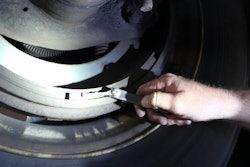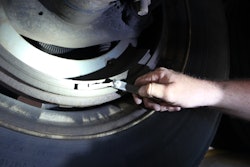By John Smith
George Sturmon suggests that urethane bushings have become more of a “mainstream” option for the trucking industry, and it is hard to argue with the owner of ATRO Engineered Systems. His company began producing the bushings for Hendrickson beam-style suspensions in 1987 and gradually has expanded the product line to include everything from torque rod bushings to transmission mounts.
The story is echoed by a number of suppliers. Urethane now is being used to produce everything from hood and cab mounts to the bushings for torque rods and suspension systems. And it can be found in suspensions with labels as diverse as Reyco Granning and Hendrickson.
The choice often is part of a bid to extend component life.
Unlike rubber, for example, urethane can withstand the chemical attacks of oil, hydraulic fluid, brake fluid, antifreeze and de-icing compounds.
“The only chemicals that will affect polyurethane are chemicals that have no business being anywhere near a vehicle,” says Energy Suspension Sales Manager Kevin Taeger, referring to solvents. In fact, he suggests that a urethane bushing can last 10 times longer than its rubber counterparts because of the decisions that are made in a laboratory to affect shape memory, rebound, hardness, tensile strength and elongation.
“Normally you have five different ingredients that make up the urethane. The beauty of urethane is you can adjust those five different chemicals,” says Sturmon. “You can change the tensile strength. You can change the tear strength. You can change the elongation…we probably pour a dozen different urethanes according to the applications.”
Indeed, the different formulas can address a number of challenges.
When the U.S. military began to enhance the armor on Humvees, the added weight was pushing the suspension’s traditional rubber bushings out of place. In contrast, urethane bushings were able to handle the added pressure.
The ride of a truck’s cab also can be improved by upgrading the bushings in the cab mount and the torque arm that limits the movement of the sleeper, Taeger adds. The use of urethane in a hood support can address the types of squeaks that can drive a trucker to distraction. And the material also can be a solution for situations in which there is a lot of rotation around the inner sleeve of a bushing.
“It does tend to be a better material, especially when a very heavy load is involved,” observes Dave Kirkham, a project engineer with Ridewell.
But advances have not been limited to urethane compounds.
The hardness of rubber also can be tightly controlled, notes William G. Nash, manager, technical services for Hendrickson’s Truck Systems Group. “You’ve got a lot of flexibility with it.”
There are also situations in which rubber may simply be a better option.
As a rubber bushing is compressed and stressed, air is able to move in and out of its pores. That makes rubber an ideal choice in an application that experiences a lot of vibration or high temperatures, says Sturmon. And Kirkham notes that rubber is the best choice in applications that require a lot of flexibility, such as a trailing arm suspension or lift axle.
“The biggest problem is not getting enough urethane where they’ll only have 1⁄16 of an inch of material in between two pieces of metal,” Taeger adds. “With rubber, you can bond it. Urethane as a rule does not like to be bonded.”
The observations demonstrate that there is still a debate surrounding the choice between the two materials.
Urethane’s supporters suggest that their favorite building material can be used to replace the bushings on virtually any suspension. “Ninety percent of all the rubber parts can effectively be redesigned with polyurethane,” says Taeger.
But other people suggest that the aftermarket should stick to the materials that are chosen by the suspension system’s original designers.
“In a trailing arm suspension, if you use a urethane bushing and it’s stiffer than what the manufacturer has set up, you could break something else because that bushing is supposed to provide the flexibility,” Kirkham warns. “We have a rubber-ride suspension that uses rubber springs and we’ve seen urethane versions of those, but they seem very, very stiff and they tend to affect the ride.”
That could lead to a harsher ride for drivers, and fatigue-related failures in fasteners and other parts.
“When you put polyurethane in [to replace a rubber bushing], you are changing the tuning of the suspension. You’re going to lose something,” says Nash, noting how applied forces simply will travel elsewhere. “It’s going to give you greater wear on other truck components, the frame rails and everything attached to them.”
Those who maintain suspension systems know that worn components can lead to problems at several different locations. It already is common practice to inspect the bolster springs and other torque rods when replacing what appears to be a single worn torque rod.
When a bushing is replaced, the work also needs to be repeated across an entire suspension system. There are no opportunities to mix and match different materials in the same position. All of the end bushings in a beam suspension, for example, should be made of the same material. The same is true when replacing center bushings.
Ultimately, one of the central arguments that have dominated the debate between rubber and urethane bushings has been the matter of price. Urethane does tend to have a higher initial cost, but those who promote the material point out that the price differential has been dramatically reduced. In some cases, the purchase prices are virtually identical.
“When we first began, [urethane] was 10 to 20 percent more expensive,” Sturmon says, referring to the differentials that existed two decades ago. “Over the years, the volume has gotten up to where we have become much more competitive.”
Outside the initial purchase price, a well-designed urethane bushing also can remain in service for much longer than its rubber counterpart, and that can have an impact on the overall cost of ownership.
“The most expensive thing on a re-bush is the labor,” Sturmon says, noting how the task can be limited to a span of every five years rather than every three years.
And urethane bushings can be easier to install.
“Rubber has to be pre-compressed,” Kirkham explains. “As a result, you have to have a press of some sort to push it into an eye. With urethane, a lot of times you can smack it with a mallet and it’s in there.”
Then again, there may be cases when it doesn’t make any sense to re-bush a suspension in the first place.
“The cost to repair a torque rod versus buying a new torque rod is just about a wash once you put labor in there,” suggests Nash, noting how his company will soon be releasing a crimped version for the Primaax EX air suspensions that are used in vocational applications.
But it will be the customers who decide between rubber or urethane.
Cost-conscious fleets may focus on rubber, while owner-operators have been more likely to embrace urethane, says Taeger. “I don’t care if he’s off-highway or on-highway, his mentality is to keep things on the road, so he is more vigilant in looking out for better products.”
The debate about which material is “better” seems to continue.








